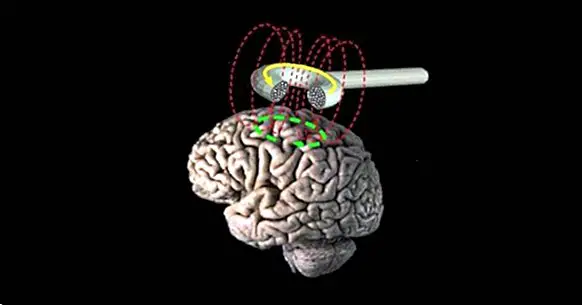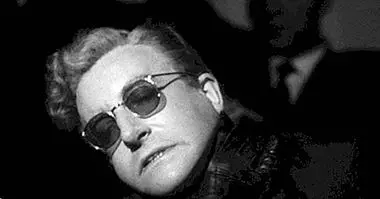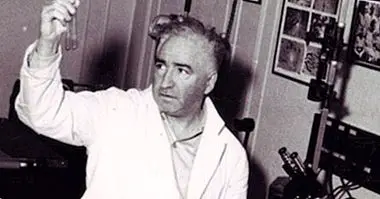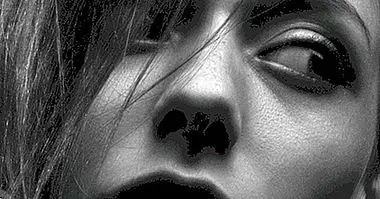Transcranial magnetic stimulation: types and uses in therapy
There are a lot of disorders and diseases that affect the brain and its functioning. These disorders can cause or be caused by the fact that sometimes different areas of the brain are not activated enough or function in an altered way. To solve them, different mechanisms and treatments have been developed or tried with greater or lesser efficacy. One of them, not very well known but that has shown some utility, is Transcranial magnetic stimulation .
Related article: "Cognitive neuroscience: history and methods of study"
What is transcranial magnetic stimulation?
The technique known as transcranial magnetic stimulation is a method or type of non-invasive intervention based on the application of magnetic fields controlled to stimulate the activity of nerve cells. This stimulation does not generate pain and allows control of the activity of the target brain areas.
The principle by which it works is the application of electromagnetic induction, applying electrical current to an electromagnet that will be placed on the scalp in such a way that the aforementioned magnetic fields are generated (sufficiently attenuated so as not to generate damage).
So, these fields they influence the transmission of information, facilitating brain activity (although it is not fully understood how it works) and the generation of action potentials through neuronal depolarization. The normal rate of activation of these neurons is interrupted, something that in turn can generate deferred effects in those neurons with which those affected by the stimulation are connected. It has been linked to depression and long-term empowerment.
The studies carried out at the moment seem to indicate that it is a methodology that has some effectiveness and that has few risks, although it is usually used as an alternative method or as a support to the treatment and not as a first option (other types of treatment that have shown greater consistency and effectiveness are usually preferred).
- You may be interested: "Parts of the human brain (and functions)"
Basic procedure
The basic procedure that is usually followed in the application of transcranial magnetic stimulation is approximately the following. Before the treatment, a visit to the doctor should be made to verify that the patient does not present any type of pathology or element for which this technique is contraindicated.
As for the application itself, in the first place, after having the patient enter the room, some type of barrier element will be provided such as plugs so that this can protect the ears. Previously it should or would be advisable explain to the patient what will happen during the session , and it may be necessary to reassure the patient (without using anesthesia or sedatives).
Then proceed to place a coil with an electromagnet on the scalp, placing it in the area that is intended to stimulate. It is possible that instead of one, there are two or several elements to be placed, depending on how the stimulation is carried out. It will proceed to perform mapping or brain mapping, introducing brief pulses to observe and locate the brain areas and their bioelectrical functioning. It is likely to notice some sensations and sounds in this phase.
After that, the doctor will proceed to turn on the coil and go regulating the intensity of the stimulation , increasing it to the motor threshold (usually until the fingers are contracted). After reaching it, finally, the magnetic field will be allowed to pass for a variable period of time depending on each case. These sessions can vary in number and temporality, being usual the accomplishment of around ten sessions.
Types of transcranial magnetic stimulation
There are different ways to apply transcranial magnetic stimulation . Some of the main types are the following.
1. Transcranial magnetic stimulation of simple pulses
One of the ways to apply this technique is with simple pulses, through the application of a stimulus every three or more seconds, or with a train of variable frequency stimuli on the same area for several seconds. Used in research or in the treatment of specific problems.
2. Transcranial magnetic stimulation of paired pulses
In this case two stimuli are applied whose intensity can be equal or different from each other, through the same coil and in the same brain region or with two different coils. Typical of the study of corticocortical connectivity .
3. Repetitive transcranial magnetic stimulation
This application is one of the best known. It is based on the emission of repeated pulses , applying a stimulus (low frequency) or more (being able to reach twenty in the rapid or high frequency EMTr) per second or less time. It is usually used in the treatment of neuropsychiatric problems.
In what diseases is it used?
Although not especially recognized, transcranial magnetic stimulation has been applied to different cerebral and psychiatric affectations . Some of the best known are the following.
1. Parkinson's and motor syndromes
One of the disorders in which the most frequent use of this technique is in Parkinson's or in problems related to its symptoms, causing functional improvements and reduction of motor problems .
- Maybe you're interested: "Parkinson's: causes, symptoms, treatment and prevention"
2. Mood disorders
Perhaps the best known application at the psychiatric level of this technique is in major depression. With an operation in part similar to electroconvulsive therapy but without the side effects of this , it has been observed that this treatment contributes to diminish the depressive symptomatology if it is applied in the left dorsolateral prefrontal, although it needs more investigation
It has also been applied in the treatment of bipolar disorder, although in this case there is a risk of inducing manic episodes. That is why in this disorder it is necessary to be especially careful.
3. Neurorehabilitation
Another area of application is in neurorehabilitation, using stimulation as a way to generate neuronal activation and to try to improve the functionality after a brain injury. It is applied among others in traumatisms, heart attacks, spinal cord injuries, syndromes of negligence, hemiparesis or cognitive difficulties.
4. Epilepsy
Epilepsy is a disorder in which this type of treatment has sometimes been used. It can allow the stimulation of some brain areas relevant to face alleviate deterioration generated by this condition , and may even facilitate the appearance of epileptic seizures in order to locate the area that generates seizures and assess the possibility of other therapeutic options.
- Related article: "Epilepsy: definition, causes, diagnosis and treatment"
5. Pain disorders
The use of transcranial magnetic stimulation has been proposed in the treatment of problems that present with pain, like neuropathies and neuralgia , or the pain of the phantom hand (in amputees), fibromyalgia or even migraine.
6. Neurodevelopmental disorders
There are investigations that suggest the use of this therapy in autism and ADHD , using the stimulation on the nuclei that govern the attention to cause improvements in the symptoms of these neurodevelopmental disorders and stimulating their attentional capacity. However, although much more research is still needed in this regard.
7. Schizophrenia and psychotic problems
Depending on the use and the stimulated areas, it is possible to find a utility of this technique in the case of schizophrenia and psychotic disorders. This is especially useful in the stimulation of mesocortical pathways, so that negative symptoms are reduced. In some cases it can also be used in the treatment of positive symptoms by altering the cerebral mechanism that produces them (although there is a risk of generating psychotic outbreaks).
Contraindications and side effects
As we have said, transcranial magnetic stimulation is usually considered a non-invasive and low-risk therapeutic option, with no major complications occurring in the majority of cases. However, this does not mean that it can not have annoying side effects or even be contraindicated in specific cases.
With regard to side effects, generally patients who undergo this treatment can experience headaches and dizziness, antips and paresthesias on the face and scalp or even some small involuntary spasms. Occasionally, however, more serious disturbances may occur, such as hearing loss, seizures, and manic episodes. That is why although apparently low risk, we must be careful with its use.
With regard to people who have contraindicated transcranial magnetic stimulation or who need to consult or inform their doctor of the presence of specific characteristics before undergoing it, those people who carry implants or have a metallic element in their organism stand out that could be altered by magnetic stimulation. Pacemaker is particularly relevant (that the stimulation could get to alter to the point of causing death), infusion pumps, elements and valves implanted in the nervous system or cochlear implants. Something as simple as dental implants can also pose a certain danger, as well as shrapnel or metal elements present in the body due to some type of accident or trauma.
Special caution is also required for people suffering from brain injuries such as recent strokes (although it is sometimes used to rehabilitate its effects, it is not recommended to apply it to infarcted patients). Although it is used as therapy in some cases of bipolarity or schizophrenia, special caution should be used in these cases because if the state of the subject is not controlled the appearance of psychotic outbreaks or manic episodes can be favored . The same goes for epilepsy. Those who consume some type of medication (whether or not it is psychotropic) should consult their doctor first. Finally, pregnant women also have contraindicated this treatment.
Bibliographic references
- Ibiricu, M.A. & Morales, G. (2009). Transcranial magnetic stimulation. Annals of the Health System of Navarra, 32 (suppl.3). Pamplona.
- López-Ibor, J.J .; Pastrana, J.I .; Cisneros, S. & López-Ibor, M.I. (2010). Efficacy of transcranial magnetic stimulation in depression. Naturalistic study. Actas Esp. Psiquiatría, 38 (2): 87-93.
- Pascual-Leone, A. and Tormos-Muñoz, J.M. (2008). Transcranial magnetic stimulation: fundamentals and potential of the modulation of specific neural networks. Rev. Neurol., 46 (Suppl 1): S3- S10.



















